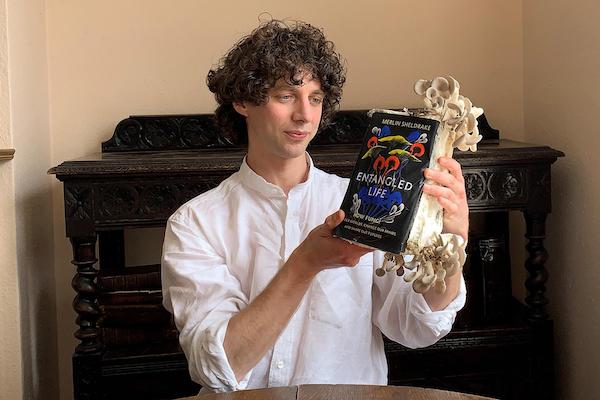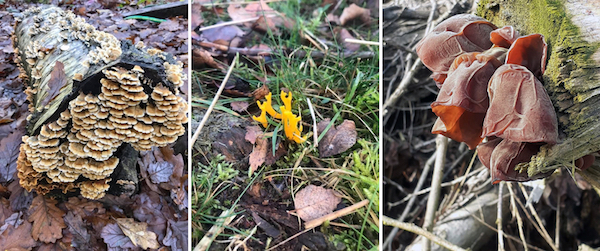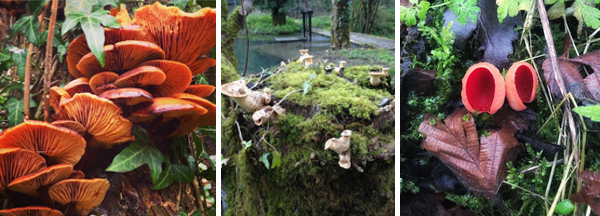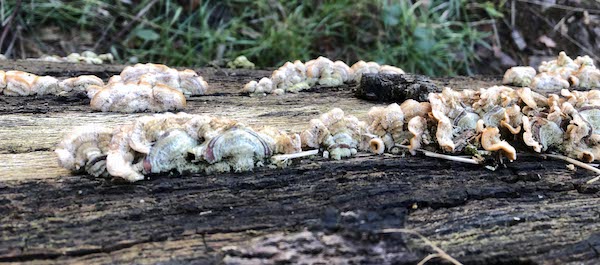Entangled Life: How Fungi Make our Worlds, Change our Minds, and Shape our Futures, by Merlin Sheldrake

“The usefulness of fungi is, for us, a lucky biproduct of their own independent lifeways, and their constancy, resourcefulness, and apparent equitability are reminders that we are not as special as we think. At a time when political and moral compasses seem broken and our lives themselves are at the mercy of a virus we cannot control, some readers may find an investigation of fungi grotesquely esoteric and irrelevant. It is neither. Life will go on. Only to ourselves are we its most important practitioners.”—Dr. Diane Fortenberry
Outside of a Dog
By Dr. Diane Fortenberry

“The authors of a seminal paper on the symbiotic view of life take a clear stance on this point. ‘There have never been individuals,’ they declare. ‘We are all lichens.’”―Merlin Sheldrake
“Some fungi have tens of thousands of mating types, approximately equivalent to our sexes (the record holder is the split gill fungus, Schizophyllum commune, which has more than 23 thousand mating types, each of which is sexually compatible with nearly every one of the others). The mycelium of many fungi can fuse with other mycelial networks if they are genetically similar enough, even if they aren’t sexually compatible. Fungal self-identity matters, but it is not always a binary world. Self can shade off into otherness gradually.”―Merlin Sheldrake

LONDON England—(Weekly Hubris)—February 2021—Last November, voters in the state of Oregon voted to legalize the use of psilocybin, the psychoactive compound found in magic mushrooms. It had previously been decriminalized in Santa Cruz and Oakland, California, and in Denver, Colorado, following clinical trials at UCLA, NYU, and Johns Hopkins that have shown that psilocybin can effectively treat depression and a wide variety of addictions. Michael Pollan relates the history of the politically thwarted scientific study of psychedelics in his superb, highly recommended How to Change Your Mind: The New Science of Psychedelics (2018). Merlin Sheldrake goes further to show in this, his first book, that there is much more to mushrooms than tripping. This extraordinary book will change the way you understand the world we live in and, just possibly, make you reconsider your place in it.
Sheldrake was born in 1987, three days after a once-in-a-century hurricane destroyed some 15 million trees across southern England and northern France, ripping their root systems from the ground. On the first full day of his life, a record fall of the Dow Jones wiped trillions off the world stock markets and triggered a global financial crash. Not good omens for anyone, but Sheldrake’s magical name appears to have bestowed an unlikely enchantment on this formidable young scientist, who holds a doctorate in Plant Science from the University of Cambridge. “My superheroes weren’t Marvel characters . . . they were lichens and fungi. [They] annihilate our categories of gender. They reshape our ideas of community and cooperation. They screw up our hereditary model of human descent. They utterly liquidate our notions of time. . . . They’re the biggest organisms in the world and among the oldest. They’re world-makers and world-breakers. What’s more superhero than that?” (from Robert Macfarlane’s Underland: A Deep Time Journey (2019), which devotes a chapter to Sheldrake’s work).
Fungi make up one of six kingdoms of living things, along with plants, animals, eubacteria (most bacteria), archaebacteria (bacteria found in thermal vents and geysers), and protists (slime molds and algae). Plants make their food by photosynthesizing sunlight, and animals feed by consuming plants or other plant-eating animals, but fungi metabolize whatever is around them, secreting digestive enzymes into carcasses, dead wood, living vegetation, even rock. They have found a home in animal (including human) guts and orifices, and their relationship with plants is more than 450 million years old—a symbiotic association in which fungi are found in more than 90 percent of all plant species. These mycorrhizal fungi (from the Greek for “fungus” and “root”) consist of mycelium, which Sheldrake describes as not so much a thing as a process—“an exploratory tendency.” Water and nutrients are transported through entire ecosystems within these mycelial networks. Mycelium is composed of hyphae, the mass of branching, tubular structures that form the body of a fungus. Mycorrhizal fungi are resident within the roots of trees and other plants; they exchange nutrients such as phosphorus and nitrogen, which plants need but cannot gather themselves, for carbon that the plants produce in the form of glucose by means of chlorophyll, which fungi lack. And they do so with amazing economy.
Sheldrake explains the work of Toby Keirs, an evolutionary biologist who wondered how mycorrhizal networks—the symbiotic collaboration of plant systems and mycelium—deal with inequality. By growing within plant roots, mycorrhizal fungi feed on the sugars and lipids produced by the plants, and in exchange supply minerals and chemicals foraged from the ground, thus feeding the plant. Keirs exposed different parts of a single fungus to varying supplies of phosphorus (crucial for plant growth), looking for “trading decisions.” Where phosphorus was scarce, she discovered that the plant paid a higher “price” in the form of more carbon for every unit of phosphorus it received from the fungus. Where phosphorus was more abundant, the fungus received a less favorable “exchange rate.” Moreover, Keirs identified a strategy of “buy low, sell high,” replicating our familiar logic of supply and demand. She showed that the fungus actively moved phosphorus from areas where it was plentiful—where it brought a low price when exchanged with the plant root—to areas where it was scarce and therefore in higher demand, using its “microtubule motors.” By doing so it was able to manipulate the plant to supply higher quantities of carbon in return for the phosphorus.

How is it that an organism without a brain can do this? As Sheldrake explains, brains are only one way of processing information, and much can be done without them, even in animals. A flatworm, for example, can regenerate an amputated head, brain and all. Researchers at Tufts University trained flatworms to remember elements of their environments, and when they regrew new heads and brains after having been decapitated, they retained that memory. The experiments suggest that the flatworms’ memory exists elsewhere in their bodies, not in their brains. There are other, more advanced cases of similar activity, for example in octopi. Most octopus nerves are distributed throughout the tentacles, which can explore their surroundings without involving the creature’s brain. When a tentacle is cut away from the body, it is still able to grasp and move. Bees, ants, and termites, which have miniscule individual brains, function as one being in a colony, and even plants, with no brain at all, have been shown to warn their neighbors of danger. (For a fascinating discussion by a panel of scientists on the various types of intelligence, see the World Science Festival presentation Intelligence Without Brains.
Andrew Adamatzky, director of the Unconventional Computing Lab at the University of the West of England, in Bristol, suggests that fungi could use electrical signaling to communicate. In 2018 he published a paper called “Towards Fungal Computer,” after experiments in which he inserted into oyster mushrooms electrodes that registered electrical activity. When he held a flame to one mushroom in the cluster, other mushrooms reacted with an electrical spike. If we could predict how a mycelial network would respond to a given stimulus, he suggested, it could become a sort of living circuit board. This may sound like science fiction, but prototype “biocomputers” using slime molds are already being used to solve geometrical problems, and some fungus species might form longer-lived networks, with more junctions between fungal hyphae, at which signals from different branches of the network would interact. According to Adamatzky, “You do not need much knowledge of how computers work to realize that such systems can create decision gates. If you combine these systems in a flexible and adaptable network, we have the possibility for a ‘brain’ that could learn and remember.”
Fungal reactions are much too slow to replace silicon chips, but Adamatzky believes that they could function as a “large-scale environmental sensor.” Mycorrhizal networks are already monitoring a host of environmental “data streams” as part of their day-to-day existence, and if we could plug into those networks and monitor their signals, we could learn what isn’t obvious about the health of an ecosystem. “Fungi could report changes in soil quality, water purity, pollution, or any other features of the environment that they are sensitive to.”
Indeed, the hope that fungi might go further than mere reportage to help clean up a wide variety of pollutants is the basis of an entire sub-field within mycology, called mycoremediation. Its longtime leader is Paul Stamets, a former logger turned passionate mycologist and one of Sheldrake’s superheroes. He is also the star of a 2019 documentary film called Fantastic Fungi [www.fantasticfungi.com], author of the influential manifesto Mycelium Running: How Mushrooms Can Save the World (2005), and presenter of a TED talk based on the book. Stamets advocates the use of fungi to clean up diesel-contaminated soil, break down pesticides, mop up crude oil, and eat plastics. Sheldrake writes about a collaboration between Stamets, an unnamed research institute in Washington state, and the US Department of Defense to break down the neurotoxin dimethyl methylphosphonate—a component of VX gas, used by Saddam Hussein during the Iran-Iraq War in the 1980s. After exposing almost 30 species of fungi over six months to increasing amounts of the chemical, two of the species adapted to consume DMMP as their main nutritional source.

Stamets thinks he may also have saved the bees. Insecticides and habitat loss have induced a steep decline in bee populations, with severe effects on over a third of global agriculture, but the biggest problem is the varroa mite, which parasitizes bees and enables the introduction into colonies of a range of fatal viruses. Wood-rotting fungi are a source of antiviral compounds, many of which have long been used in Chinese medicine. Stamets collaborated with the US National Institutes of Health and the Department of Defense after 9/11 in an effort to find compounds that could be used against viral terrorism; the studies indicated that some of Stamets’ extracts from wood-rotting fungi were highly effective. When these were tried on bees’ viral infections, the effects were “unambiguous,” reducing some viral infections by 80 to 90 percent.
Fungi have been shown to neutralize everything from TNT to synthetic dyes, human and veterinary drugs not filtered out by water treatment plants, and even E. coli and heavy metals. They were the first living things to appear at Chernobyl after the nuclear explosion there, growing on the reactor walls and seemingly using the radiation as a source of energy. The first thing to grow from the soil of Hiroshima after its nuclear destruction was, reportedly, a matsutake mushroom. A company in Finland has adopted mycofiltration techniques to reclaim gold from discarded electronics. Researchers in Mexico City have discovered that the Pleurotus mycelium—the oyster mushroom—grows happily on a diet of used disposable diapers: over two months, diapers from which the plastic was removed lost 85 percent of their mass, compared to 5 percent in controls without the fungus. Moreover, the oyster mushrooms that fruited were free from disease and perfectly edible.
Mycoremediation, for all its various successes, will not solve our pollution problems overnight. It is naïve to suppose that dropping a fungus into a new environment will remediate a site on its own, and Sheldrake cautions that what works in a petri dish will not necessarily behave the same way “in the rumpus of a contaminated ecosystem.” In response to this realization, and inspired by Stamets’ advocacy, the mycologist and hip-hop artist Peter McCoy established an organization called Radical Mycology, based on a concept of grassroots empiricism. In an example of real-world research, McCoy trained Pleurotus mycelium (oyster mushrooms again) to digest cigarette butts, some 750,000 tons of which are thrown away annually. Used cigarette butts are saturated with toxic residues that impede their biodegrading, but McCoy “weaned Pleurotus onto a diet of used butts by gradually phasing out the alternatives. Over time, the fungus had ‘learned’ how to use them as its sole food source.”

And fungi can be used to build things as well as break them down. The external layers of portabello mushrooms show potential as a replacement for graphite in lithium batteries, and some mycelium species have been used as a substitute for human skin, helping wounds to heal. An American company called Ecovative is taking the idea very seriously. Sheldrake visited the research and manufacturing facility in Upstate New York and discovered mycelium lampshades and a stool covered in mycelium leather and padded with fungal foam. The foam is also used as padding to ship everything from Dell computer servers to bottles of wine. Boards, bricks and acoustic tiles made from fungi are designed to replace plastics, concrete and particle board. Hundreds of square feet of mycelial leather-like textiles can be grown in a week on waste materials, and when they are no longer needed, the products can all be composted, to be used as food by other fungi. IKEA is developing ways to replace polystyrene packaging with mycelial alternatives, and NASA is researching the possible role of “mycotecture” to grow structures on the moon.
If there is a theme that runs through this book, it is the ways in which fungi can a) teach us ways of living that are better for us and the other occupants of the planet, and b) help us to clean up the mess we have made of that shared world. Perhaps this theme is inevitable in a book written by a human being, for a wide audience. This is not to suggest, however, that Sheldrake doesn’t also discuss fungi on their own terms (insofar as he is able, given his species), and such concepts of interactivity in the non-human world as the Wood Wide Web are no longer startling (see, for example, Peter Wohlleben’s The Hidden Life of Trees: What they Feel, How they Communicate—Discoveries from a Secret World, published in 2015). For many of those who have experienced the effects of psilocybin, the main pleasure is that of feeling connected to the wider, more-than-human world, and of accepting one’s own smallness within it. Despite our ingenious manipulations, the kingdom of fungi does not exist for our benefit and will continue long after we are gone—by our own hand or otherwise. Fungi thrived for millions of years before plants learned to photosynthesize, and they comprise the largest, and longest-lived organisms in the world today: a sprawling honey fungus in Oregon has been calculated to weigh hundreds of tons, extends across some 10 square kilometers and is between 2,000 and 8,000 years old; larger, older specimens probably lie undiscovered.
The usefulness of fungi is, for us, a lucky biproduct of their own independent lifeways, and their constancy, resourcefulness, and apparent equitability are reminders that we are not as special as we think. At a time when political and moral compasses seem broken and our lives themselves are at the mercy of a virus we cannot control, some readers may find an investigation of fungi grotesquely esoteric and irrelevant. It is neither. Life will go on. Only to ourselves are we its most important practitioners.
One Comment
Jean
This is an astonishing and fascinating article, Dr Fortenberry. Thank you. I read it twice, and will need to do so again, as the material is so new (to me) and strange. I sent it to several people, and am waiting impatiently for them to read the work so we can discuss it! Ten sq km, and ancient. That amazing redefinition of omnivore. Thank you so much! This is immensely comforting, isn’t it?